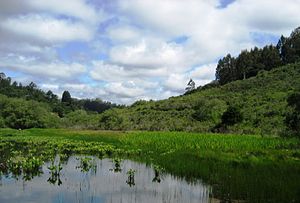| Ellicott Slough National Wildlife Refuge | |
|---|---|
IUCN category IV (habitat/species management area) | |
 Calabasas Pond | |
Map of the United States | |
| Location | Santa Cruz County, California, United States |
| Nearest city | Watsonville, California |
| Coordinates | 36°55′36″N 121°50′17″W / 36.92661°N 121.838°W[1] |
| Area | 168 acres (0.68 km2) |
| Established | 1975 |
| Governing body | U.S. Fish and Wildlife Service |
| Website | Ellicott Slough National Wildlife Refuge |
The Ellicott Slough National Wildlife Refuge is a United States National Wildlife Refuge located in the northern part of the Monterey Bay area of California.
Originally established to protect the habitat of the threatened Santa Cruz long-toed salamander subspecies, Ellicott Slough also harbors other species later federally listed as threatened due to habitat loss, including the California red-legged frog, California tiger salamander[2] and robust spineflower.
The refuge was established after the California Department of Fish and Game purchased the property from its original owner. It is made up of four discontinuous units all separated by less than 2.7 miles.
The refuge experiences a mild climate influenced by the Pacific Ocean. Temperatures are generally from 50 to 75 °F (10 to 24 °C).[3] The terrain is both hilly and flat.[4]
- ^ "Ellicott Slough National Wildlife Refuge". Geographic Names Information System. United States Geological Survey, United States Department of the Interior.
- ^ Masters, Ryan (2 January 2016). "Cell tower appealed on salamander grounds". Santa Cruz Sentinel. Retrieved 5 January 2016.
- ^ US Fish and Wildlife Service (September 2010). Ellicott Slough National Wildlife Refuge Final Comprehensive Conservation Plan and Final Environmental Assessment (PDF) (Report). United States Government Publishing Office.
- ^ Loredo, Ivette. "Conceptual Management Plan". U.S. Dept. of the Interior, U.S. Fish and Wildlife Service 2005.
{{cite web}}: Missing or empty|url=(help)
